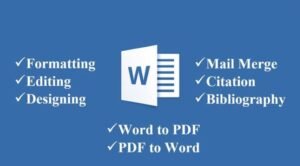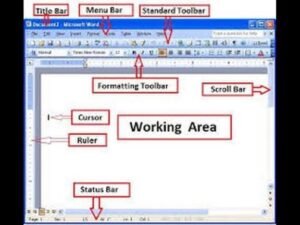Uses of MS word
Microsoft Word is a fundamental tool in the modern digital landscape, serving myriad purposes across diverse domains. From personal projects to professional endeavors, its versatility and functionality make it indispensable. Here’s an in-depth exploration of the uses of Microsoft Word, spanning various contexts and applications:
1. Document Creation and Formatting:

Microsoft Word is primarily known for its word processing capabilities, enabling users to create a wide array of documents effortlessly. From letters and resumes to reports and essays, Word provides a comprehensive suite of tools for crafting polished and professional documents. Its intuitive interface and formatting options allow users to customize text, paragraphs, and pages to suit their specific requirements.
2. Business Correspondence:

In the realm of business, Microsoft Word is extensively used for drafting official correspondence, including letters, memos, and proposals. Its robust editing features, such as spell check and grammar check, ensure accuracy and professionalism in written communication. Moreover, Word’s ability to integrate with email platforms facilitates seamless communication and document sharing within organizations.
3. Academic Writing and Research:

Students and researchers rely on Microsoft Word for academic writing projects, including term papers, theses, and dissertations. Word’s citation and referencing tools streamline the process of citing sources and generating bibliographies, adhering to academic standards such as APA, MLA, and Chicago styles.
4. Resume and CV Creation:
Job seekers leverage Microsoft Word to create compelling resumes and curriculum vitae (CVs) that highlight their skills, qualifications, and professional experience. Word offers a variety of resume templates and design elements to help individuals craft visually appealing and well-structured resumes tailored to specific job opportunities.
5. Desktop Publishing and Design:
Microsoft Word serves as a basic desktop publishing tool for designing flyers, brochures, newsletters, and other promotional materials. While not as feature-rich as specialized desktop publishing software, Word provides essential layout and design tools for creating visually appealing documents.
6. Data Organization with Tables and Charts:
Word’s table and chart functionalities enable users to organize data, create spreadsheets, and visualize information effectively. Tables can be used to present numerical data, lists, and schedules in a structured format, while charts and graphs help illustrate trends, comparisons, and patterns within the data.
7. Collaborative Writing and Review:

Collaboration features in Microsoft Word facilitate teamwork and document collaboration in real-time. Multiple users can work on the same document simultaneously, track changes, and leave comments for feedback and review. This collaborative environment fosters efficient communication and enhances productivity, especially in group projects, document revisions, and peer editing scenarios.
8. Form Creation and Data Collection:
Word enables users to create interactive forms with fields for collecting information, feedback, or survey responses. Forms can include checkboxes, radio buttons, drop-down menus, and text fields for user input, making them suitable for various purposes such as registration forms, feedback surveys, and data collection initiatives.
9.Publishing and Sharing Documents:
Microsoft Word facilitates the publication and distribution of documents across multiple platforms and formats. Users can save documents in standard file formats such as PDF, HTML, and RTF, ensuring compatibility and accessibility across different devices and software applications.
10. Accessibility and Inclusivity:
Word’s accessibility features, including screen readers, keyboard shortcuts, and alternative text options, make documents more inclusive and accessible to users with disabilities. By adhering to accessibility guidelines and standards, such as WCAG (Web Content Accessibility Guidelines), Word empowers users to create content that is usable and inclusive for all individuals.
In conclusion, Microsoft Word’s versatility and functionality make it an indispensable tool for a wide range of tasks and applications, spanning personal, academic, and professional domains. Its intuitive interface, robust features.
Top 10 Laptop Brands in India click here
